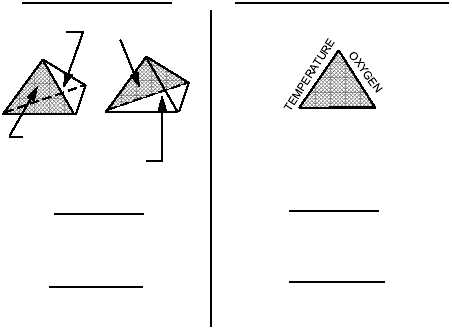both sustain itself and grow. This process of fire is now
called the "fire tetrahedron." See figure 12-3.
The most common method of controlling or
extinguishing a fire is to eliminate one or more of sides
of the tetrahedron. This can be accomplished by the
following methods.
1.
Smothering—removing the oxygen
2.
Cooling—removing the heat
3.
Starving—removing the fuel or combustible
matter
There are two terms you need to understand about
fires. These are the fire point and the flash point.
The
fire point
of a substance is the lowest
temperature at which its vapors can be ignited and will
continue to burn. At this temperature, the vapor will
ignite spontaneously in the air. Also, substances don't
have to be heated to this ignition temperature
throughout in order to ignite.
The flash point of a substance is the temperature at
which the substance gives off enough vapors to form an
ignitable mixture with the air near the substance's
surface. An ignitable mixture is a mixture within the
explosive range. The mixture is capable of spreading a
flame away from the source of ignition when ignited.
For example, fuel will spontaneously ignite when a
portion of it (or its vapors) is exposed to temperatures
around 500°F (ignition temperature). It is capable of
being touched off by a match or spark at temperatures
down to -5°F (fire point). It will also flash across the
surface at temperatures from -5°F down to -45°F (flash
point). From these examples, you can readily see that
fuel has a low flash point and is easily ignited. Fuel is a
constant fire hazard around aircraft.
A spark, heat
caused by friction, or an electrical discharge could
supply enough heat to cause fuel to flash.
CLASSES OF FIRE
Different types of fires are combated by different
means. It is important that you know how to identify
the various types of fires and understand why each type
must be combated in a specific way.
Class A
Class A fires occur in combustible materials, such
as bedding, mattresses, books, cloth, and any matter
that produces an ash.
All fires of this class leave
embers, which are likely to rekindle if air comes in
contact with them. Class A fires must not be considered
extinguished until the entire mass has been cooled
below its ignition temperature. Smothering (removing
the oxygen) is not effective for class A fires because it
does not lower the temperature of the smoldering
embers below the surface. The extinguishing agents
most effective for class A fires are solid water stream,
both high- and low-velocity fog, CO2, and water
immersion.
12-2
FLAMING COMBUSTION
AND
SURFACE GLOWING COMBUSTIONN
TEMPERATURE
OXYGEN
FUEL
FUEL
NO CHAIN
REACTION
FUEL IS IN FORM OF
INCANDESCENT SOLID
OXYGEN IS AT
INTERFACE OF
GLOWING FUEL
UNINHIBITED
CHAIN REACTION
OF COMBUSTION
PROCESS
DIFFUSION & CONTINUOUS
REIGNITION & AUTOMATICALLY
OBTAINED AT FLAME
TEMPERATURE LEVELS
FUEL IS IN FORM OF
VAPOR AND GAS
Anf1203
3
Figure 12-3.—Tetrahedron and fire triangle.

